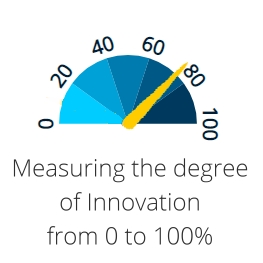How to measure Genuine Innovation?
Pseudo-innovation terms like incremental innovation could only exist because of lacking innovation measurement. The battle between Innovation and Improvement may come to an end. Both are vital for a company’s success, yet they are entirely different. This post builds on the previous post: Genuine innovation versus improvement. Looking at the definition of genuine innovation is one thing, and even that has room for interpretation. Still, having a measurement for breakthrough or genuine innovation, it becomes much clearer what is what. To frame our work and the focus of BlueCallom, we needed at least to state how we understand Innovation. This is our statement:
Innovation is a breakthrough that elevates
people and organizations in the way they do things
that were not possible before
Now, this statement can be obviously debated, as we can even debate our existence. But for our work around groundbreaking innovation, we must share with others what we are up against. The more profound question is how do we measure innovation to better differentiate between innovation and improvement of something already existing? NOTE: Improvement is essential to advancing an existing solution or service. But Innovation does not improve an existing solution.
10 Key Aspects of Innovation
 The result of innovation is that it elevates the way how people or organizations do things that were not possible before. The following key aspects are vital contributors to breakthrough innovation and keep reminding us that Innovation is not just a single idea. We formed those key aspects into questions that must be answered very digitally as a Yes or No to be very clear. We gave each aspect a weighted percentage, and the sum would be 100%.
The result of innovation is that it elevates the way how people or organizations do things that were not possible before. The following key aspects are vital contributors to breakthrough innovation and keep reminding us that Innovation is not just a single idea. We formed those key aspects into questions that must be answered very digitally as a Yes or No to be very clear. We gave each aspect a weighted percentage, and the sum would be 100%.
Some of those aspects may be foreign to you or make no sense to you. But Innovation is so much more than just features and functions. Data aggregation may seem impossible, but there are always ways to get there. Data is the base for every decision – even 100,000 years ago, long before we could calculate, let alone have computers.
1) Solves an unsolved problem
The new solutions solve a big problem and elevate how they do things to a degree it was impossible before.
Yes/No 50%
If NO, you can stop here – it is no innovation.
2) New essential functions
The innovative solution contains essential functions not existing in any similar product.
Yes/No 5%
3) Environmental care
The level of environmental care is recognized in initial research as superior to any comparable solution.
Yes/No 5%
4) Initial Customer Experience
The way people purchase or otherwise acquire the solution is substantially easier, safer, or otherwise more attractive compared to competing solutions.
Yes/No 5%
5) Data Aggregation
The degree of data aggregated by this new solution that is used and intelligence extracted from those data supersede any comparable solution.
Yes/No 5%
6) Advancement
The new solution significantly increases productivity, safety, savings (Time, Money, energy…), entertainment, and environmental advancement.
Yes/No 5%
7) User Experience
The way the user or consumer interacts with the solution has reached a new level compared to previous solutions.
Yes/No 5%
8) Business Model Integration
The complexity of how business models, products, and organizational innovations interact makes it almost impossible to copy such a solution.
Yes/No 10%
9) Market Shifts
With the inception of the innovation, competitors and suppliers are inspired to change how they conduct business.
Yes/No 5%
10) Ecosystem Development
The new solution inspired other businesses to introduce new and adjacent products or services to the market.
Yes/No 5%
If all questions are answered with a clear yes, you have 100% Innovation. 70% or 80% is still an innovation but has room for improvements and increases the probability of becoming your market’s preferred solution.
Who Decides the degree of Genuine Innovation?
Most companies would run the first round if reviewed internally by the innovation team and people you may ask to become a judge. But eventually, you will need to ask the market to provide feedback. You will want to interview the early adopters of new solutions. The focus is obviously on the first and defining question: Does the solution help solve the people’s problem and elevates their doing to the degree that was not possible before? An old investor proverb says: “The market always wins.” Same here, indicating that if your market does not see the innovative character of your new solution, it may need more significant adjustments.
To hear more about this topic, ask questions or enter the discussion,
Join us on Nov 9, to our innovation thought leader webinar Genuine and Pseudo Innovation.
https://dev.bluecallom.com/genuine-versus-pseudo-innovation/
In any case, I would love to hear your opinion about the characteristics of innovative solutions or companies.


Leave a Reply
Want to join the discussion?Feel free to contribute!